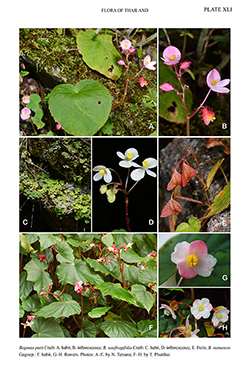e-Flora of Thailand
Volume 14 > Part 3 > Year 2019 > Page 416 > Begoniaceae > Begonia
44. Begonia saxifragifolia Craibwfo-0000825443
[§ Diploclinium], Bull. Misc. Inform. Kew 1930: 414. 1930; Craib, Fl. Siam. 1: 777. 1931; Hughes, Annot. Checkl. SE Asian Begonia. 113. 2008. Plate XLI: C–E.
Accepted Name : This is currently accepted.
Synonyms & Citations :
Description : Monoecious acaulescent herb, 5−8 cm tall. Stems tuberous, globose or subglobose with numerous fibrous roots, 5−8 mm diam. Leaves 1 (–2) per plant; petiole pale green or sometimes dark red, brown when dry, 4−5 cm long; lamina basifixed, succulent, symmetric, chartaceous when dry, adaxial surface glabrous, light green or reddish brown, abaxial surface glabrous, pale green or vinaceous, palmatifid, 4−10 by 7−11 cm, leaf incision partite, base subcordate, apex acuminate, margin minutely double serrate, venation palmate, veins 6−8, prominent beneath. Stipules persistent, pale green, lanceolate, 1−3 by 1−2 mm, apex acute, margin entire. Inflorescences arising from tuber, dichasial, bisexual, 8−12 cm long, staminate flowers basal, pistillate flowers distal, protandrous; peduncles dark red or reddish brown, ca 4−5 mm long, terete, glabrous, glossy. Bracts persistent, pale green, membranaceous, lanceolate, 1−2 by 0.5−1 mm, apex acute, margin entire. Staminate flowers: pedicels 4−10 mm, ascending; tepals 4, plain white, outer 2 orbicular, 4−6 by 4−7 mm, base rounded, apex obtuse, margin entire, outer sides covering with minute echinate hairs, inside glabrous, inner 2 obovate, 4−5 by 4 mm, base cuneate, apex rounded, margin entire, glabrous on both sides; androecium actinomorphic, globose, stamens 30−40, bright yellow, filaments fused at base, ca 1 mm long, anthers obovate, ca 1 mm long, dehiscing by short slits near tip. Pistillate flowers: pedicels pale green or dark red, 5−10 mm long; tepals 3, unequal, outer 2 orbicular, 4−6 by 4−7 mm, base rounded, apex rounded, margin entire, outer sides with few minute echinate hairs, inside glabrous, inner 1 oblanceolate, 4−5 by 2 mm, base cuneate, apex obtuse, margin entire, glabrous on both sides; styles 3, fused at base, bright yellow, stigmatic band crescent-shaped and covered with minute papillae; ovary with 3 unequal wings, pale green with red striations, 3-locular, placentae bilamellate. Fruit a dehiscent capsule, pale green, pendulous, drying light brown, 5 by 11−12 mm; locules ovate, 5−6 by 5 mm, abaxial wing 10−12 mm long, 5–6 mm at base, 2 lateral wings shorter, triangular, 4−5 mm long. Seeds brown, barrel-shaped, 0.3−0.5 mm long.
Thailand : PENINSULAR: Chumphon, Ranong (type: Kerr 11804, syntypes -ABD BM K), Phangnga, Trang; SOUTH-WESTERN: Kanchanaburi.
Distribution : Endemic.
Ecology : On shaded karst limestone cliffs with water seepage, 50−100 m alt. Flowering: July–September; fruiting: September–November.
Vernacular : Kam kung tham (ก้ามกุ้งถ้ำ)
Notes: Previously known only from Peninsular Thailand, recent surveys have revealed a large population on limestone cliffs in Ban Tha Khun district, Surat Thani. Further exploration of limestone hills in Ratchaburi and Prachuap Khiri Khan provinces between the two disjunct localities would be valuable.

